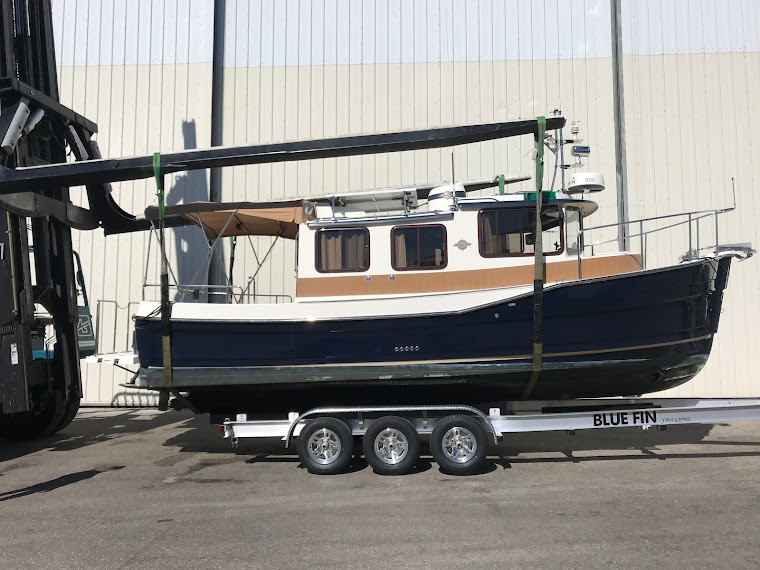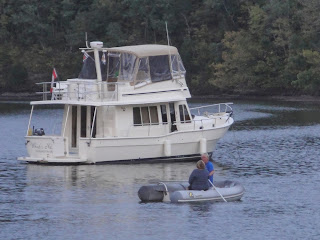Florence, AL and her
sister cities
After catching up with
Rick and Deb and enjoying their joint rowing efforts, we left early for our run
up river to Florence. This is really
four cities – Florence on the north side of the river and Muscle Shoals, Sheffield
and Tuscumbia on the south side. Beside catching up on chores and stocking our
pantry, we sampled the major attractions of this beautiful area aglow with fall
colors. Florence boasts a restored main street most of which dates from the
1880s to 1920s. There we found numerous restaurants and shops although the big
box national stores are on the outer loop road. Taking advantage of the
courtesy car for longer than usual since no one else was in the marina, we made
pilgrimages to the birthplaces of WC Handy – the Father of the Blues and Helen
Keller.
The log cabin where
Handy spent his youth was preserved, moved into town and joined to a museum and
library in his honor. Handy was the
first to use “the Blues” in a song title and he is credited with bringing
attention to the blues sound. Among his
famous works are “Beale Street Blues”, “Memphis Blues”, and the highly
acclaimed “St. Louis Blues”, which was based on his own near homeless
experiences in St Louis. Amazingly he continued to compose after he went blind
in his early seventies. Examples of his
compositions in braille were included among the many artifacts of his storied
life.
From this blind musical
prodigy we crossed the river to Tuscumbia to visit the birthplace and childhood
home of Helen Keller. She was born in
the cottage on the property but moved to the larger house at Ivy Green after
the illness that destroyed her hearing and eyesight. It was here that she finally learned to
associate the signed word water with the water coming from the pump. The home
has been preserved with more than 85% original furnishings from her family’s
time there and includes many photos and mementos of her life. The main house was actually built in 1820 by
her grandparents and occupied by her parents until their death. It is
surprisingly spacious and gracious but gives a good idea of the life young
Helen knew. The cook’s room and kitchen
building sit behind the main house and the two room cottage is nearby. This
complex was part of a 650 acre plantation in Helen’s youth, but it is now only
a large garden closely surrounded by the town.
The Frank Lloyd Wright’s
Rosenbaum house was another surprise.
Just a few blocks from the marina on a quiet bluff overlooking the river
is an example of Wright’s Usonian architecture. During the depression he sought
to keep building homes by offering modest priced small houses. This gem remains
today since Mrs. Rosenbaum and her sons gave it to the city on the condition
that they make the needed restorations.
The original home cost about $14,000 but the city spent more than $750,000
to restore it in 1999. Today it stands much as Wright envisioned as a small
scale home blending into its site with indoor outdoor views from each
room. Sadly the view of the river has
been lost with new development and the growth of trees, but the gardens still
provide decoration for the walls of windows. This house is also unique since
Wright later designed an addition which was essential as the family grew to
include four boys. The original kitchen
was about the size of my boat galley and in a dark corner. The addition included much needed storage as
well as a larger kitchen, a bunk room for the boys and a second dining
area. The living space, study and
bedrooms have beautiful windows to the gardens, low ceilings around the edges
with a clearstory around the raised center.
This low horizontal multi-roof style was a Wright hallmark. Although
beautifully connected to the views, there are quirky aspects of the house that
would make it hard to live in today. In
fact several of them, the multiple levels and steps plus the very, very narrow
doorways and halls, are why Mrs. Rosenbaum had to move out when she broke her
hip. Also, the kitchen is still very dark, the addition kind of wanders and
wastes space, bathrooms are tiny, and storage is still limited. I can admire
the beautiful spaces but would not want to live in or maintain them. Nevertheless,
to see Wright’s ideas embodied in this small-scale, cozy home, tucked away in
Florence AL, was a treat.
In spite of the chilly
weather, we walked to the nearby Indian Mound and Museum on the Tennessee
River. This mound was probably for
ceremonial use not a burial site. The
archeologists date it to the middle Woodland Period which pre-dates the
Mississippians. Since the mound is now virtually surrounded by the port it is
amazing that the area has been preserved, but it speaks to the long occupation
of this strategic site on the Tennessee River.
The collection of arrowheads was impressive.
This area was important
for several reasons. The city of Muscle
Shoals reportedly got its name from the mussels that lived in the shoals along
this stretch of the river. Evidence
shows that ancient people harvested the mussels here as an important source of
food. In addition, the river was navigable down to the Ohio and then to the
Mississippi giving easy access to this area for the earliest people as well as
European settlers. Nowadays there are
dams which cover the shoals and let us continue on up the river. The city of
Muscle Shoals is now famous for the music created and recorded here in the 60s
and 70s by the likes of the Osmonds, the Rolling Stones, Rod Stewart and many,
many others. Although smaller in scale, the music recording business and
performance scene is still alive and vibrant with many venues. Sadly, it is not
Nashville since most of the action is only on the weekends and our visit was
during the week. We also missed the Coon Dog Cemetery, Pope’s Tavern Museum and
of course the antique stores, so we will have to stop here again on our way
back down the river.
P.S. Our stop Florence Harbor Marina
included some excitement for Frank. He
got locked out of the cabin for more than 4 hours while we were off running
errands and touring. It was "reported"
that he did some exploring and slid off the upper helm in a dramatic
fashion. We surely got an earful from
this very quiet non-vocal feline on our return, but thankfully he didn’t abandon
ship. All of us have learned our lessons – Frank doesn’t venture outside unless
he can see Steve, and we count noses a little better when we lock up.










































No comments:
Post a Comment